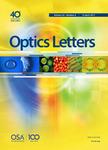版权所有:内蒙古大学图书馆 技术提供:维普资讯• 智图
内蒙古自治区呼和浩特市赛罕区大学西街235号 邮编: 010021

作者机构:Jiangsu Normal Univ Sch Phys & Elect Engn Xuzhou 221116 Peoples R China
出 版 物:《OPTICS LETTERS》 (Opt. Lett.)
年 卷 期:2025年第50卷第4期
页 面:1069-1072页
核心收录:
学科分类:070207[理学-光学] 07[理学] 08[工学] 0803[工学-光学工程] 0702[理学-物理学]
基 金:National Natural Science Foundation of China
主 题:Bragg reflectors Finite-difference time-domain method Laser arrays Q factor Refractive index Waveguide modes
摘 要:We numerically design a compact nanolaser based on a topological guided-mode resonance (GMR) structure. It consists of a topological junction formed by two GMR gratings, which induces a leaky Jackiw-Rebbi (JR) edge state that confines in-plane light within a small mode volume. Using the finite-difference time-domain (FDTD) method to simulate active optical responses, we show that surface-emitting lasing is achieved with a threshold of 4.5 mu J/cm2 within a cavity length of approximately 2.0 mu m. In addition, by replacing the junction with an array of equally spaced ridges in a critical phase, the edge mode transitions into a bulk mode. This modification allows for controllable cavity sizes of 4.9, 7.8, and 10.7 mu m, with corresponding thresholds of 6.0, 8.4, and 9.0 mu J/cm2, achieved by using 5, 10, and 15 cycles of critical state grating. The topological GMR holds promise for compact coherent sources. (c) 2025 Optica Publishing Group. All rights, including for text and data mining (TDM), Artificial Intelligence (AI) training, and similar technologies, are reserved.